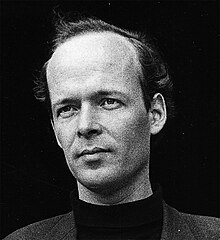|
Gerhard von Graevenitz
Gerhard von Graevenitz (19 September 1934 Schilde, Prignitz/Mark Brandenburg – 20 August 1983, Habkern/Traubachtal) was a German kinetic artist,[1][2] co-founding member of the Nouvelle Tendance[3] and member of the op-art movement.[4] He also belonged to the international circle of the Zero-Group.[5] He is seen as one of the uncompromising representatives of the constructive-concrete art of the younger generation (since 1958). Life and workGerhard von Graevenitz' father was head of a district council ('Landrat'). As the youngest of four brothers (he had a twin sister), he studied economics at the University of Frankfurt (1955–1956), and at the Academy of Fine Arts, Munich (1956–1961). His professor there was Ernst Geitlinger. Together with Jürgen Morschel he edited the magazine nota, which appeared in four numbers (1959–1960) and was dedicated to international art and concrete poetry. Both started the gallery nota in Munich (1960/1961),[6] showing solo-exhibitions of Otto Piene, Heinz Mack, Almir Mavignier and François Morellet. They organized lectures, e.g. by the information-theorist Max Bense. In 1961, von Graevenitz lived in Paris, where he was in contact with the Groupe de Recherche d'Art Visuel (GRAV) and shared a studio with Julio Le Parc. In 1962 he was co-founder of the international movement Nouvelle Tendance (new tendencies, Neue Tendenzen). Until the group's break-up in 1965, he was one of the four organizers of the international group-shows, operating from Munich. The first solo-exhibition of his work was organized in 1962 at Gallery Roepcke in Wiesbaden. He participated in exhibitions such as "the Responsive Eye" (1965) MOMA, New York and "Licht-Kunst-Licht" (1966) at Van Abbemuseum /Eindhoven.[7] In 1970 he settled in Amsterdam. In the 1970s, he repeatedly worked as an independent organizer and curator of exhibitions, such as for the Dutch Pavilion of the Venice Biennale ("To do with nature", 1978 ), for the Kölnische Kunstverein ("Kunst < > Natur", 1980 )[8] and for the Hayward Gallery in London (1980, assisted by Norman Dilworth ) and the Kröller-Müller Museum in Otterlo (1980) : "pier + ocean, Reflections on Construction in the 70's".[9] In 1976 he co-founded the Internationales Künstlergremium and worked for it as its vice-president in 1978/79. From 1979 on he was a member of the board of Stichting de Appel in Amsterdam. KineticsIn 1958, after initial painterly experiments with material, he began his white monochrome reliefs ("White Structures") with concave and/or convex points or circles, showing structures as progressions, degressions and chance constellations on a grid. In 1961, he created his first kinetic object, and, from 1963 onwards, light-objects, He installed his light-wall in 1966 (which was shown in London, Eindhoven and in 1969 at the Venice Biennale ). He constructed "play-objects", some of them meant as models for multiples, and in 1962 he made serigraphs in many series, investigating non-hierarchical fields on the basis of chance-operations similar to his first kinetic objects . From 1972 onwards he used the possibilities of a chance-generator for computer-graphics, aided by the mathematician Rolf Wölk. For some years from 1968 his large kinetic wall hung in the foyer of the Gemeentemuseum Den Haag. In 1968 he participated in documenta 4 in Kassel with three large kinetic objects. In the 1970s he installed kinetic environments in Nürnberg (1969), Milan (1973) and Amsterdam (1977).[10] Changing structuresIn his work, von Graevenitz investigated and systematically visualized the phenomena of perception as determined by variable movements, light projections, space, time, chance and order. He was engaged with the optical illusion of movement ( Op art ) as well as real movement, using invisible motors and mechanics. He aimed to show a changing structure of geometrical elements with their unforeseeable movement, open for indeterminable constellations, - mostly on a contrasting ground. He intended for the eye to engage in game playing. In the late 1960s, non-hierarchical fields of the same elements gave way to fewer and larger elements, which were more complex in their movement. E.g. he created one concave elliptical element which moved completely alone on its ground. In opposition to the representatives of the first constructive movement ( Piet Mondriaan, Max Bill ) von Graevenitz did not believe in a Modernist utopian value of his art, but took it to be a special model for thoughts about how networks of relationships work in general.[11] Personal lifeHe was married to art historian Antje von Graevenitz, with whom he had two children. Catalogue-raisonné
Participation in a film
Participation on TV
Further literature and catalogues (a selection)
See alsoReferences
External linksWikimedia Commons has media related to Gerhard von Graevenitz. |
||||||||||||

